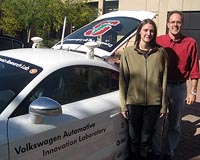 |
Al-Ain, UAE (AFP) Nov 3, 2009 A laboratory in the UAE has built what it says is the world's first Arabic-speaking robot which could soon go into mass production to serve as staff in shopping malls. Ibn Sina, named after the 11th century Islamic philosopher and scientist commonly known in English as Avicenna, was designed by a team at UAE University in the city of Al-Ain, which is part of Abu Dhabi emirate. "It is the world's first Arabic-speaking conversational humanoid robot," Nikolaos Mavridis, assistant professor of computer science at the university who led the team, told AFP in an interview. "He enables us to do research and he is also quite an educational tool because the students love to do projects on him." Mavridis, a Greek expat who has worked with a team of about 12 people, including Emiratis and international students, said the robot could be used as a receptionist, sales staff or shopping assistants in malls. "There is a number of things he can do on his own: answer a couple of questions, connect to the Internet to get information and show you things on the screen regarding what you want to buy," he said. "We're very close to being able to get him to work as a receptionist or a helper in a mall. If we work on it in a group of five people, we will be able to develop those skills in six months to make him ready for full operations. "Already we have had him work for a full day in Al-Ain Mall," he said. Ibn Sina sports a white cloak, golden-trimmed robe, a turban and grey beard -- a look Mavridis said aims to reflect the appearance of the original character, who was born near Bukhara in then Uzbekistan. Speaking in classical Arabic, he answers questions with human-like facial expressions. The artistic and mechanical design of Ibn Sina, including motors which allow it to make facial expressions, was carried out by Hanson Robotics, while the software was devised by Mavridis and his team. The team worked for more than a year on developing the software system that consists of the mind of the robot, including developing his vision, speech, memory and motion. Ibn Sina has software modules that enable it to see, detect faces and objects, as well as subsystems to conduct dialogue, transcribe speech to text, understand and talk back, Mavridis explained. He said the lab has already been approached by companies interested in the robot either for shopping malls or as receptionists. "We have some basic interest. Things are in progress," he said. Ibn Sina was developed using funding that was injected to set up the lab and the College of Information Technology at the university, which came directly from the ruler of Abu Dhabi. About 200,000 dollars was spent on developing the technology behind the robot that is also used for other projects in the lab. "Given all the growth that is happening right here at this moment, it's important that apart from building the largest tower in the world and all of these beautiful buildings, to try to do something that has to do with scientific and intellectual achievements," Mavridis said. "For that reason we chose Ibn Sina as the character from which our robot was inspired in order to bring back his values to our students ... He brings together a lot of traditions, ancient and more recent traditions." According to the global market intelligence firm Information Data Corporation (IDC), expenditure on information technology services in the United Arab Emirates is expected to grow 12.4 percent between 2008 and 2013. It will surpass 1.83 billion dollars by the end of that period, it says. Share This Article With Planet Earth
Related Links All about the robots on Earth and beyond!
 Driver-less car in high-speed rally assault
Driver-less car in high-speed rally assaultStanford, California (AFP) Nov 2, 2009 Imagine driving at top speed on a steep, winding mountain pass in the Alps, or the Himalayas, or the Rocky Mountains. Now, take your hands off the steering wheel and cover your eyes. Or grab a camera and take some pictures of the snowy mountain peaks. Or send a text message to a friend describing the scenery. You'd skid off the road and plunge into a deep ravine within seconds, right? ... read more |
|
| The content herein, unless otherwise known to be public domain, are Copyright 1995-2009 - SpaceDaily. AFP and UPI Wire Stories are copyright Agence France-Presse and United Press International. ESA Portal Reports are copyright European Space Agency. All NASA sourced material is public domain. Additional copyrights may apply in whole or part to other bona fide parties. Advertising does not imply endorsement,agreement or approval of any opinions, statements or information provided by SpaceDaily on any Web page published or hosted by SpaceDaily. Privacy Statement |